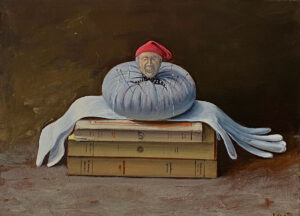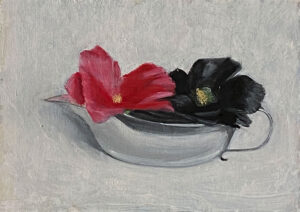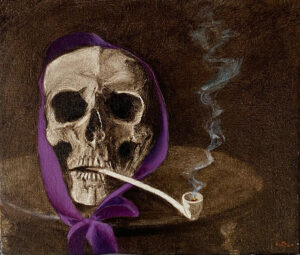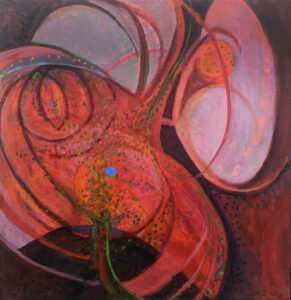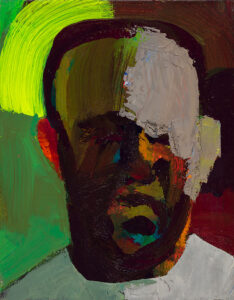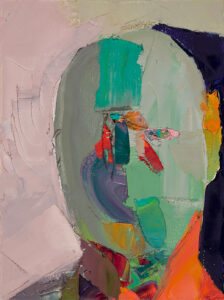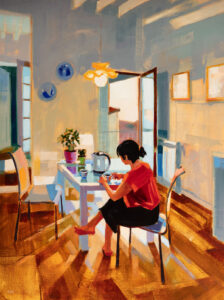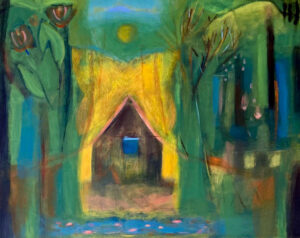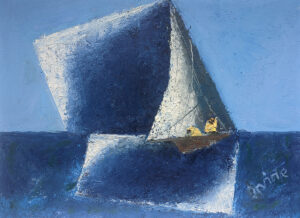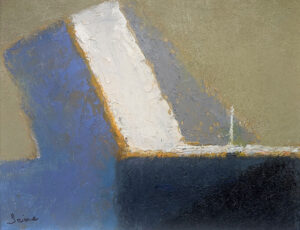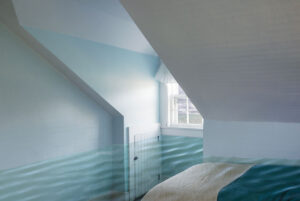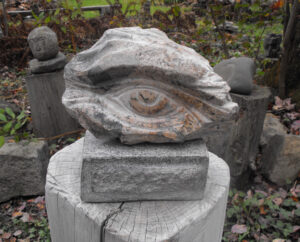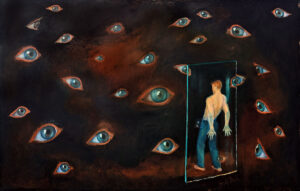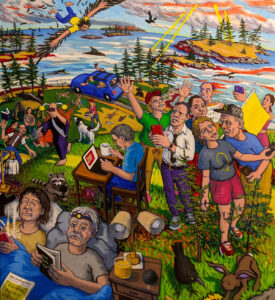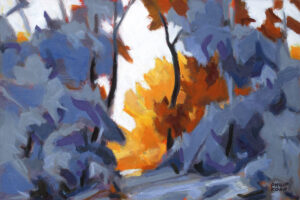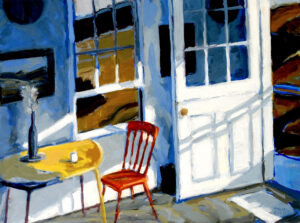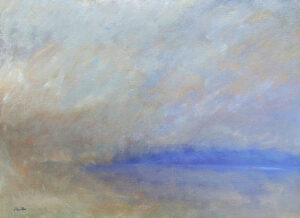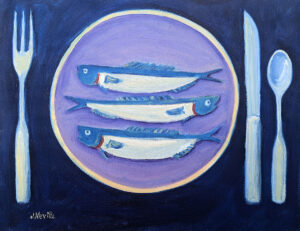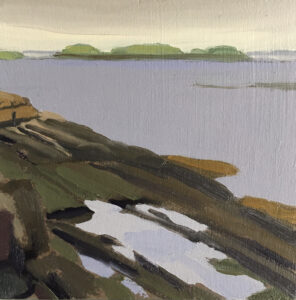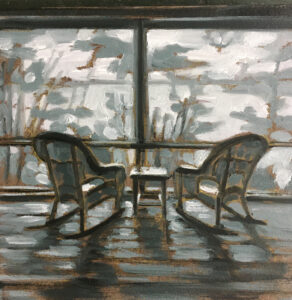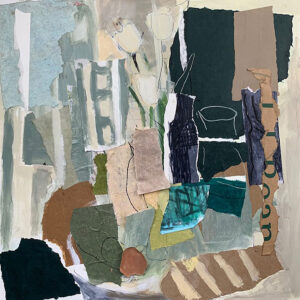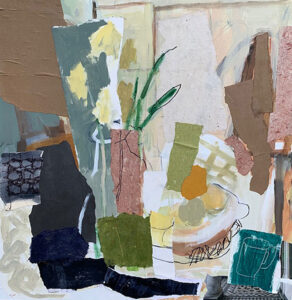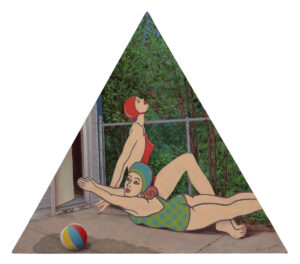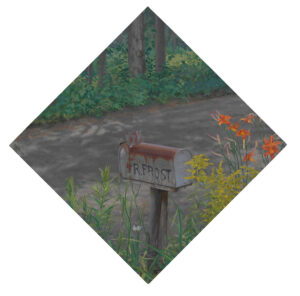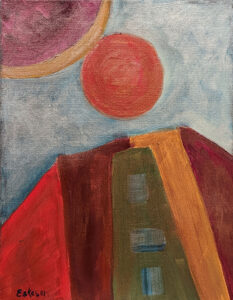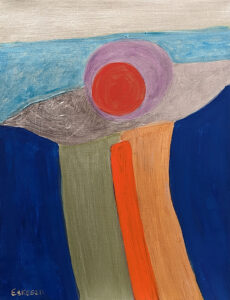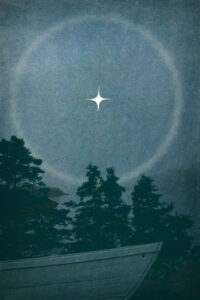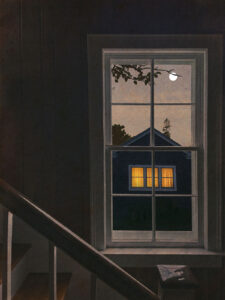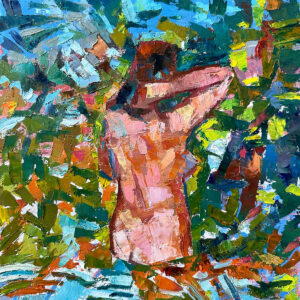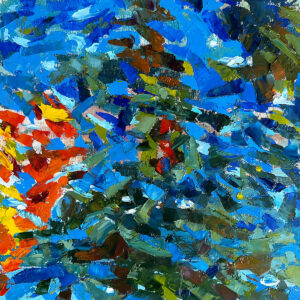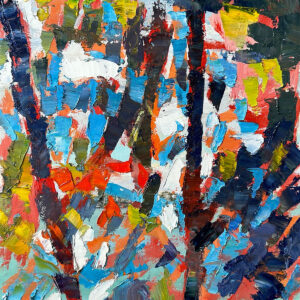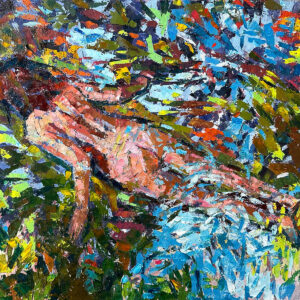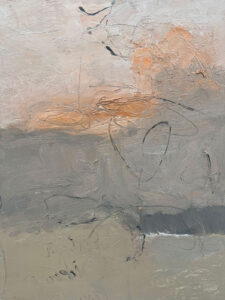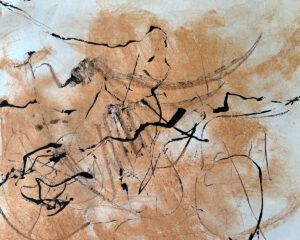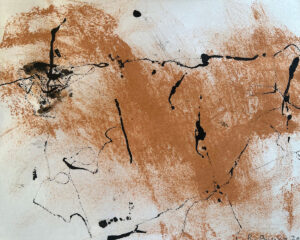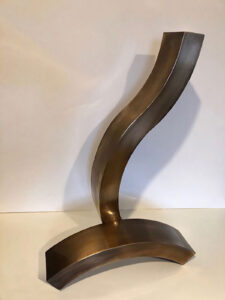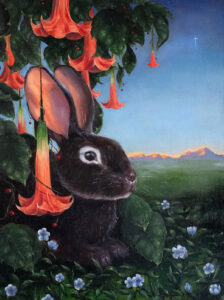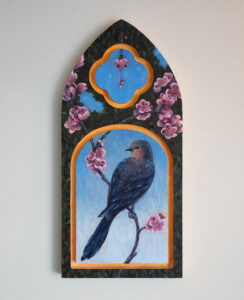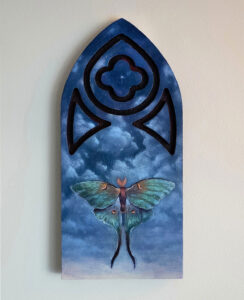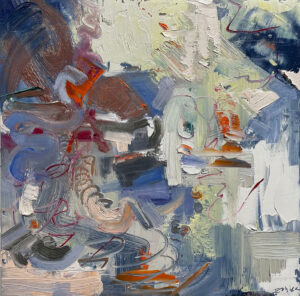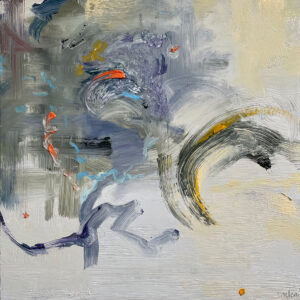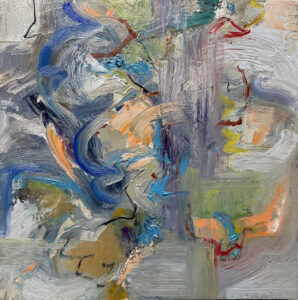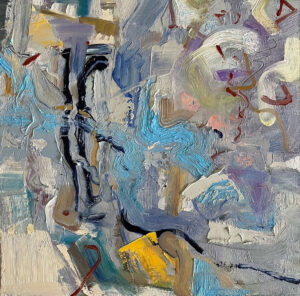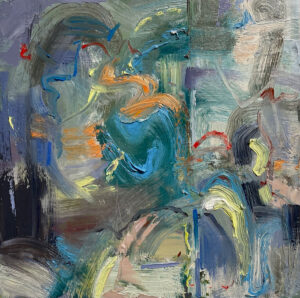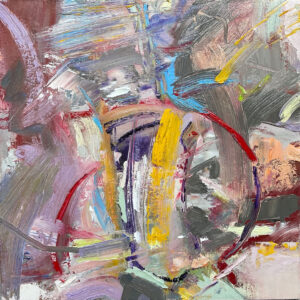December 6 – January 18, 2024
The Mind’s Eye: Turning Inward
Artists Reception: Wednesday, December 6, 5–7pm
The Mind’s Eye: Turning Inward explores the transition from summer to fall and winter. People naturally retreat indoors this time of year physically, and mentally. The hustle and bustle of summer has subsided, the sunlight begins to wane, and the days get shorter, and colder. The Mind’s Eye invites Courthouse Gallery artists, and guest artists, to reflect on this seasonal change, to push boundaries, and to create from within. The results to this challenge are intriguing. Below are comments and statements by a selection of the artists in the show.
Participating Artists: Jeffery Becton, Lise Bécu, Judy Belasco, Ard Berge, Ragna Bruno, Tom Curry, Heidi Daub, Kate Emlen, Elaine Eskesen, Rick Fox, Philip Frey, June Grey, William Irvine, Joseph Keiffer, Philip Koch, Sarah LaFontaine, Rosie Moore, Emily Muir (1904–2003), John Neville, Linda Packard, Stephen Porter, Alison Rector, Robert Shillady, Lilian Day Thorpe.
Read MoreSaturday by plein air landscape painter Rick Fox comes from his recent studio practice of head paintings that respond directly to his reflection. The paintings are made spontaneously, without conscious ideas about color or backstories. For Fox, “The results are amusing to me and feel like a record of, and an introduction to unexpected aspects of myself.” Fox lives in Kittery, Maine.
The objects in The French Pin Cushion by Joseph Keiffer were harvested from a flea market in France. The figure on top of the pin cushion is a reference to the French Revolution when the red cap was worn by the hard-liners, such as Mme. LaFarge in Dickens’ Tale of Two Cities. The cap was also called the Liberty Cap or the Phrygian Cap and it is believed the hat was worn by freed slaves in Turkey during ancient times. The white gloves were worn by a bride or one of her brides’ maids, and the books are the kind that were the standard format for all paperback books in France during most of the twentieth century. “These random French lives have more in common now than they ever could have imagined while living. I have given them a second life,” says Keiffer, who lives in New York City, and has been painting the Maine landscape for over twenty-five years.
This past summer realist landscape painter Judy Belasco vividly remembered creating an abstract painting as a teenager while living in an artist colony in Provincetown with her family in the late 1950s. Abstraction was the genre of that era, and Belasco found the process interesting, but only to a point. After decades of painting representational landscapes, Belasco wondered how she would feel working in abstraction now. “When working on Interior Energy, I was drawn to the color red as the base from the beginning. Aside from that, everything I knew went out the window. Each day in the studio was a new adventure with lines, form, space, color, and movement. I had control, but it was different from landscape painting. It was definitely not boring!” Belasco realized she was painting dots for the first time, and it occurred to her that these dots emerged from being steeped in Aboriginal art from many years of visiting Australia, as well as four adventure trips deep into the Australian Outback. “One never knows, but it all threads together in its own fashion.” Belasco splits her time between Philadelphia and Stockton Springs, Maine.
Realist painter June Grey loves painting quiet, peaceful landscapes of Maine. The artist stepped out of her sanctuary with Wash My Sins Away, a bold, red abstract she painted for The Mind’s Eye. Reflecting on this past year, Grey said she made choices that fueled growing frustrations and unhappiness. Wash My Sins Away was inspired by driving through a car wash says Grey. “That red tornado beating against the windows, washing away all that grime, brought out the sunshine. Life is good again!” June Grey lives in Enfield, Maine.
Philip Frey and his partner, Isabella, find peace and clarity through their own meditation and contemplation practices, as well as their morning rituals such as making coffee or tea. Morning Reflections in Florence was inspired by a recent trip the couple took this fall to Rome and Florence, Italy. Frey’s experience on this trip brought new opportunities for him to explore the Italian light in an urban interior setting allowing him to explore the importance of the morning ritual. Frey lies in Sullivan, Maine.
Paintings by guest artist Heidi Daub like Among the Sail of Roses and The River and the Butterfly evolved from a stilling and attunement, coupled with an urgency to render human interdependence with the natural world. “The resultant images of coalesced line, form, color and movement are a discovery born out of the complexities of love and daily experience.” For Daub, this call is a welcome invitation to dwell a bit longer among the internal rustlings. Daub lives in Blue Hill, Maine.
In response to The Mind’s Eye, William Irvine, who works exclusively from his memories and imagination said: “At my age the minds eye has gathered so much information that is now distilled and is a mine to be explored and brought to the surface. So I work in my studio giving light to buried feelings.” For this show, Irvine painted three seascapes— Sailing the Green Sea, The Blue Cloud, and Bringing in the Sails—on small 12 x 16 inch panels like the paintings from his White House series, which often depict men and women in front of a modest white house like the ones that dotted the landscape of Troon, Scotland, where Irvine grew up.
Jeffery Becton created Olivia’s Room for his friend Olivia, who invited Becton into her husband’s family summer cottage to capture its essence before it was sold. The husband had tragically died from Parkinson’s several years earlier, and the house was being put on the market by his surviving sisters. Olivia had hoped that its memories would still be intact for the photo shoot, but Becton was too late. The generational collections of sea glass and heart shaped beach rocks had been swept into garbage bags and replaced on the shelves with ceramic lighthouses made in China. Family watercolors of islands and sailboats had been replaced with fake needlepoint sayings and tacky framed “Maine” art from TJMax. The old quilts, loved to death stuffed animals, and antique lamps with faded silk shades were all gone. “As I walked through the rooms looking for things to photograph, Olivia sat much of the time on the porch with my wife Hillary reminiscing and crying. The sense of grief from having to let go, whether one was ready to do so or not, was palpable. I wanted to create a room in this quickly disappearing house where she could protect her past, where she could lie down and dream, a place where her fondest and oldest memories could not only survive, but revive her. I wanted to create a gentle and inviting safe haven not just for Olivia, but for all of us.”
When Lise Bécu received the invitation to participate in The Mind’s Eye, she had just made a sculpture titled EYE. “When looking at that piece of stone, I saw an eye and this is the sculpture that came out. The sculpture reminded me of a friend who recently passed away. This verse from the poem Daffodils by William Wordsworth summed up my feelings about my friend and this piece.”
For oft, when on my couch I lie
In vacant or in pensive mood,
They flash upon that inward eye
Which is the bliss of solitude
And them my heart with pleasure fills,
And dances with the daffodils.
Although artist Emily Muir (1904–2003) was best known for her paintings of Maine there are a number of artworks in the Muir estate where she explored more soul-searching subjects. Eyes Watching depicts a young man teetering on the threshold of a doorway depicted by a simple white line. He is shirtless and barefoot, wearing just blue jeans, his torso arched and his arms pushing against an invisible barrier. A room full of red-rimmed, blue eyes watch him. Is this a crossing from one dimension to another? Could this be Muir’s way of processing the premature death of her beloved husband William Muir, a noted sculptor, who died a full 39 years before his wife? We will never know, but as with all art, only the viewer’s interpretation matters.
Linda Packard, who works mostly in abstraction, finds inspiration by experimenting with new materials and tools. They create unexpected surprises and inform her next painting. For Stepping Off the Trail, Packard found a beautiful piece of unprimed linen during a recent studio move. “I could not resist trying out every medium in the studio just to see the reaction. Most of my experiments never make it out of the studio, but this one was exciting to me. It’s like a giant sketchbook page.”
SOS by Robert Shillady is a direct response to the deluge from social media, the Internet, and AI, all of which have fostered misinformation and conspiracy theories that in his opinion are tearing this country and the world apart. Known for the many historical and art references embedded in his work, Shillady has a modern-day Icarus in SOS about to crash into the techno chaos below—perhaps from multiple warnings about spending too much time on Facebook, Instagram, and TikTok. Center stage is a self portrait of Shillady sitting at his desk quietly surfing the Internet that belies his angst. However, his comment in response to SOS sums it up: “Starting in January of 2021, I was able to sleep each night for a year and a half. In the last 6 months, I find myself awake in the middle of the night wanting to scream. Again.” Shillady lives in Brooklin, Maine.
Kitchen Table, Truro Studio by Philip Koch was begun in the Cape Cod studio of painter Edward Hopper, where Koch has spent numerous residencies. For Koch, the onset of colder weather causes many people to spend more time at one’s kitchen table. “It becomes a base camp for reflecting and ruminating. Maybe Hopper sat here and reminisced over his morning coffee.” In Koch’s painting Opening, he finds that winter provides a different kind of insular drama. “In this scene a heavy snow blankets the forest with solemn intimacy and quiet. Yet, the afternoon sun sets the hillside ablaze from a small opening in the trees.”
John Neville is known for his use of bold colors in his nostalgic portrays of bygone days which chronicle the folklore and daily lives of the local fishermen and their women from his childhood village of Hall’s Harbour, Nova Scotia. For The Mind’s Eye Neville tried something completely different with Island in the Fog. Here, he uses a soft muted palette to represent the thick fog of an island that appears to be moving through the water. “The wake along the shore is like the one from a slow-moving ship, moving one way on the incoming tide, and back again on the outgoing tide.” In Breakfast Neville painted a rare still life. “This is the fisherman’s breakfast, freshly caught fishes. A feast for the most wealthy.”
For Alison Rector, memories of sitting by the water inspired two small painting for The Mind’s Eye. In Memories of the Sea bold shapes, blocks of color, and dark rocks holding tide pools that reflected a stormy sky came to mind. In Memory of the Lake, Rector recalled a quiet day sitting on a porch at the lake with a friend as the water lapped at the water’s edge. “I imagined a quality of light, black and white, and the musical sounds of a conversation shared in filtered light through the trees.”
Rosie Moore enjoys the intimate nature of an interior space, especially when she spends more time indoors during the winter. Known for her loosely painted seascapes and interiors, Moore began experimenting in recent years with mixed media and collage on canvas to create interiors exclusively. “I am trying to keep my work as fluid as possible and to find a balance between ambiguous space and familiar images. I am also continuing to experiment with the challenge of mixed media.” Moore met that challenge with her painting Still Life with Wallpaper, by organizing a multitude of colors, textures, materials, shapes, layers, and marks into an intriguing spacial interior composition.
Guest artist Ard Berge, the concept of the Mind’s Eye: Turning Inward makes him think of peak experiences when the observed world either suddenly makes profound aesthetic sense or presents a riddle from which we cannot look away. I have pursued this particular kind of encounter in my paintings by employing non-standard formats for his canvases.
Bathing Beauties portrays two vintage painted signs of female swimmers—likely dating to the 1920s and 1950s—seen resting against each other in anticipation of being mounted on a New England pool house roof where they spend every summer. A “meta” painting of paintings, these idealized figures of aquatic beauty are set within a triangular canvas which mirrors the shape of their combined placement. Although the triangle is a traditional symbol of stability, one of the bathers appears poised to jump into the darkness of an open door to the left while an inflatable pool ball slowly dries next to her, suggesting that the fun is over.
In Return to Sender, we encounter the rusty mailbox of the great American man of letters Robert Frost facing a dusty country road. Set within the center of an equilateral diamond-shaped canvas, the image nevertheless feels dynamic, unsteady, and calls to mind other examples of this geometric form’s use by Italian Futurist artists like Gino Severini, whose work explored speed and new technologies. Despite this modern context, the painting’s realistic details reward slow looking and careful reading. The title, Return to Sender, seems to pose questions. What is being sent back—something that we no longer need? Or does it acknowledge that even in a world of constant change, it is us who must return; to nature, to poetry, and to human connection.
Rising and Setting by Elaine Eskesen are about light being expressed though color, movement, and balance. For Eskesen these qualities are especially relevant as we move into the darkness of winter. “Rising represents the optimism of a new day, and a reminder that life is beautiful every day. Setting represents a time for reflection and gratitude. I throughly enjoyed being engaged while painting these paintings. I hope viewers will reflect and enjoy them as much as I did.”
For Lillian Day Thorpe, the arrival of shorter, colder days empowers her to embrace her introversion and to settle into stillness. She challenged herself to create an interior composition that turns inward on two levels, figuratively and physically. The result is Late Return with its multiple layers. Beginning in a darkened stairwell the viewer looks through a window that frames another multidimensional scene—the outdoor space between this house and a neighbor’s house to a large picture window awash with a golden light from within, to a beautiful moon-lit sky in the far-off distance. For Thorpe Late Return conveys her personal experience of glimpsing the external world through a window or portal. Thorpe, who grew up in Brooksville, lives in Portland, Maine.
Tom Curry finds reflections in slow moving streams to be very calming and meditative. The swimmers in Bather and Stream Swimmer are moving through a confetti of broken colors in the dark cool waters. “These four paintings are created with dabs of concentrated oil paints, easy to understand from a distance, but abstract when you move closer to the surface of the painting.”
Ragna Bruno listens to classical music when she paints. and inform much of her work. Bruno has heard her favorites, Schubert, Bach, and Schumann, so many times she knows every note. “The energy and emotion of the music is like a wave that washes over my being,” says Bruno. “It moves something around in me that must come out.” The mixed media paintings on Japanese paper, Reminiscing and Joyous, came from this place and remind Bruno of the following thoughts:
Red Earth
Black and White
Are the Essence
And Colors of Spain
Sculptor Stephen Porter has worked with cubes, curves, and circles throughout his long career, primarily in stainless steel, but also in wood and granite. Recently, Porter has wanted to do something different. “I switched to bronze because I wanted to move away from stainless steel. I like the quality of the material and the color of the patina. I also like ribbons, partly because they are also different. With Double Bronze Ribbon, the shapes are now different, as well as the color of the patina. In a way, I have found bronze is more difficult to work with than stainless. The welding is different and although the need for the patina is difficult to achieve, I like the result, and I find they look handsome in a home.”
Emerging artist Sarah LaFontaine enjoys designing illustrative paintings and creating scenes that feel like small portals to an ethereal plane like Rebirth and Renewal. Lafontaine uses gothic panels to emulate the spirit of the Renaissance and Gothic art periods. Their shape is directly affiliated with the architectural styles of Prague, Florence, and Vienna popular at the time. “I want my work to celebrate the spirituality and sacrality of the natural world. Although symbolism drawn from human history and mythos embodies the majority of my work, I hope viewers will discover their own interpretations.”
For landscape painter Kate Emlen, the invitation to participate in The Mind’s Eye caused her to look inward and to try something completely new. Emlen was inspired to paint in abstraction. She created six small 10 x 10 inch abstract paintings representing moments from her summer memories with titles like The Water Sustains Me and Each Night Brings Stars. “I found tubes of paint I hadn’t touched in years. I turned up the music to fill the studio. I was thoroughly absorbed in the work and enjoyed myself.”
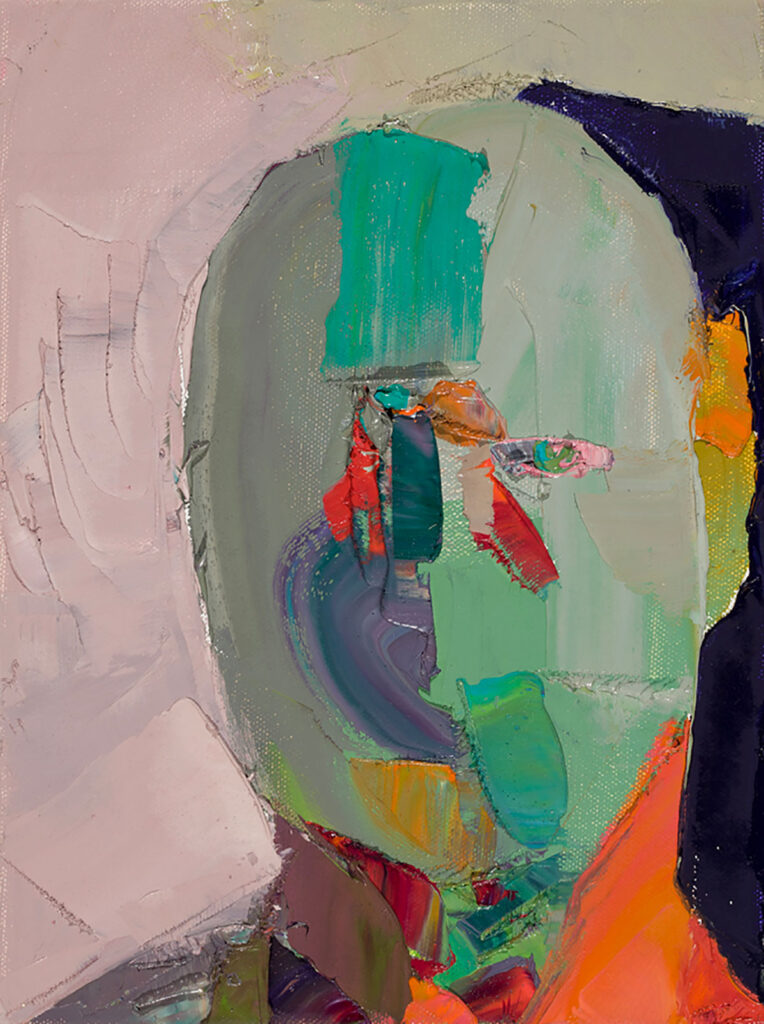 RICK FOX
SATURDAY
oil on canvas, 12 x 9 inches
$2000
RICK FOX
SATURDAY
oil on canvas, 12 x 9 inches
$2000 